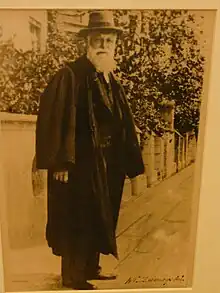Władysław Zamoyski
Count Władysław Zamoyski (1853–1924) was a French-born Polish nobleman (szlachcic), diplomat and heir of Kórnik, Głuchów, Janusz, Babin and Bargów (estates in the Grand Duchy of Poznań). Having acquired estates on the Polish side of the Tatra Mountains and in Zakopane, he was an early ecologist and philanthropist. He was mentor to Józef Retinger, who was to become an international political activist during the two world wars and beyond, following the death of the latter's father.
Władysław Zamoyski | |
|---|---|
| Count | |
.png.webp) Count Władysław Zamoyski in later life | |
| Coat of arms | Jelita |
| Predecessor | Władysław Stanisław Zamoyski |
| Born | 18 November 1853 Paris, France |
| Died | 3 October 1924 (aged 70) Kórnik, Poland |
| Noble family | Zamoyski |
| Father | Władysław Stanisław Zamoyski |
| Mother | Jadwiga Działyńska |
| Occupation | diplomat, landowner, ecologist, philanthropist |
Early life
He was born in Paris the elder son of general Władysław Zamoyski, Crimean War veteran, and Jadwiga née Działyńska. He had two sisters, Maria (1857–1858) who died in England and a further Maria Zamoyska (1860–1937). In 1871 he took the baccalauréat at the Lycée Charlemagne and between 1874 and 1878 made four attempts to gain entry to the École polytechnique. It is not certain that he succeeded as sources vary on the subject.[1][2] He served in the French Army and rose to the rank of second lieutenant. As a representative of the French government, he travelled to Australia and Oceania to take part in exhibitions and brought back valuable ethnographical items.[3]
Activity in Poland

Zamoyski moved to Poland when he inherited Kórnik (with the castle, library and arboretum) in Greater Poland, and other properties from his uncle, Jan Kanty Działyński in 1881. In 1885, as a French citizen, he was expelled from Kórnik by the Prussians and consequently moved to Zakopane in Galicia. There, he promoted the activity of the Poznań (mortgage) Bank. In 1889, concerned to save the Tatra forests, he bought at auction the Zakopane estates, beating by one cent, the bid of the timber and mining industrialist, Józef Goldfinger. With Andrzej Chramiec he succeeded in bringing the railway from Chabówka to Zakopane and building a Macadamised road link to the mountain resort.
He succeeded in winning a boundary dispute with Hungary at the International Tribunal in Graz over the ownership of Morskie Oko, the Tatran lake and the adjacent territory.[4]
In France
He next travelled back to France where with his surviving sister, Maria, he founded several charitable and educational institutions for the Polish émigré population, notably, Opieka Polska. He was chairman of the Czci i Chleba charity and was a co-founder of the Polish Literary and Arts Society.
Later years
He returned to Poland in 1920. Neither he nor his sister ever married. He left all his properties to the Polish nation in his will, and initiated the Polish Institute of Dendrology in Kórnik.
Distinctions
- Officer's Cross Order of Polonia Restituta (13 July 1921)
![]()
- Grand Cross Order of Polonia Restituta (10 November 1933), posthumously by President Ignacy Mościcki).
![]()
See also
References
- confirmation of studies at the École polytechnique
- , and cast doubt on his attendance at the École polytechnique
- Kalendarium biograficzne Władysława Zamoyskiego opracowane przez Marię Łuczak in: Stanisław Sierpowski (ed.), Władysław Zamoyski 1853-1924, publ. Kórnik-Zakopane 2003, p. 263–271, ISBN 83-85213-41-4 (in Polish).
- Great Lakes Around the World
Bibliography
- Stanisław Potocki, Władysław Zamoyski, in: Wielkopolski słownik biograficzny, Warszawa-Poznań 1981, PWN ISBN 83-01-02722-3